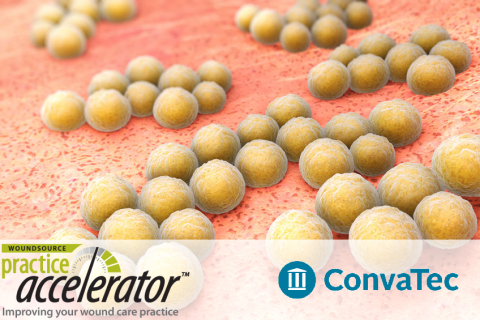Hard-to-Heal Wounds: The Effects of Biofilm
December 31, 2020
Biofilms are found in the majority of chronic wounds and pose a critical health threat, causing nearly 80% of refractory nosocomial infections. They also have a damaging virulence mechanism, which induces resistance to antimicrobials and evasion from the host’s immune system.1,2 Over 90% of chronic wounds contain bacteria and fungi living within a biofilm construct.3 Biofilms have been reported as major contributing factors to a multitude of chronic inflammatory diseases. Given the resistance of the bacteria, biofilms increase the risk of infection and cost the health care system millions of dollars annually.4 Clinicians should have practical knowledge of the role and impact that biofilms play in impeding chronic wounds, thus leading to risks of complications such as infection.
What Are Biofilms?
A wound that fails to heal with standard therapy in an orderly and timely manner is defined as a chronic, or hard-to-heal, wound.5 Impaired wound healing occurs in various wound types, but it is frequently not identified early on, causing complications and increased health care costs.6 Early detection of biofilms is essential in treating and managing hard-to-heal wounds. Advancements in molecular microbiology, microscopy technology, and techniques for studies of bacteria have increased our ability to identify the existence of biofilms.7 Biofilms delay healing during the inflammatory phase of wound healing.
The presence of biofilm triggers a chronic inflammatory response that results in a high number of neutrophils and macrophages that surround the biofilm. The neutrophils and macrophages (inflammatory cells) start to secrete high levels of reactive oxygen species and proteases (matrix metalloproteinases and elastase). The role of proteases is to help break down attachments between biofilms and tissues to dislodge the biofilm from the wound. The reactive oxygen species and proteases can also damage normal healing tissues, proteins, and immune cells and can impair healing.8
How much do you know about infection management? Take our 10-question quiz to find out! Click here.
Biofilms are normally composed of bacteria, fungi, viruses, proteins, extracellular DNA, biogenic factors, and other types or microorganisms. These are all microscopic, but as biofilm matures it will then attach to wet or moist surfaces in a viscous substance called exopolymeric material. Biofilm protects microorganisms from the body’s natural immune response, thereby preventing antibodies from reaching them. Delayed healing results from damage of the healing tissue. As it develops, biofilm moves through the following stages: attachment, microcolony formation, maturation, and dispersion.
The stages of biofilm formation and maturity start with individual planktonic (free-floating) bacteria that adhere to the wound surface within minutes. The initial attachment is reversible, but the attachment becomes stronger as cells multiply and change their gene expressions. The bacteria begin to grow and colonize within the wound surface to then form strong colonies within two to four hours. Cells aggregate, form microcolonies, and excrete initial extracellular polymeric substances that include a wide variety of proteins, glycoproteins, glycolipids, and extracellular DNA, and the resulting biofilm becomes highly tolerant to antibiotics, antiseptics, disinfectants within six to 12 hours.
The biofilm becomes larger and fully matures, and cells form multilayered clusters, leading to subclinical signs of infection within two to four days, depending on the species and growth conditions. Biofilms rapidly recover from forms of mechanical disruption and are ready to re-form and disperse mature biofilms with 24 hours to colonize other surfaces. Quorum sensing systems are how the cells communicate within the bacterial community using chemical signals. This impacts cellular functions, population density–based pathogenesis, nutrient acquisition, transfer of genetic material between the cells, motility, and synthesis of secondary metabolites.9
Biofilm Identification
Biofilms have differing characteristics reflecting the microbe aggregates. This variability necessitates a tailored approach to the specifics of the biofilm. Biofilm composition, physiochemical properties, climaxed indigenous microbiota, virulence, microbial numbers and host’s pathophysiology, and immunological fitness will determine resistance to interventions. The biofilm phenotype state is fundamental in resolving hard-to-heal wounds in a timely manner. All microorganisms can attach onto any surface, and it has been proposed that it is not only biofilms that are present in chronic wounds, but also pathogenic biofilms.10 It is important to collect wound samples to identify suspected pathogens in chronic wounds.
There is no “gold standard” test to define biofilm presence or a quantifiable biomarker. Differentiating planktonic or biofilm phenotype pathogenicity in chronic wound infection is a major barrier to effective treatment. It is vital to understand that both culture and DNA-based methods do not differentiate between bacteria growing planktonically or growing in biofilm communities; therefore, performing microscopy and/or selective culturing would be warranted in detection. There remains the question of where in the wound to take the biopsy or sample, as well as whether one sample is enough.11
Antibiotic Resistance
Antibiotics can eradicate bacteria, but once the antibiotic is suspended, the remaining cells can stir up infection again, causing antibiotic resistance. Antibiotic-resistant genes carry mobile genetic elements, such as plasmids. This process causes irreversible genotype changes in the bacteria, apart from resistance genes harbored on mobile genetic elements.12 The bacterial cells that survive antibiotics are known as persister cells. These cells block synthesis of peptidoglycan or DNA. Regrowth of biofilm will occur with a susceptibility profile similar to that of the original because of the cell’s sensitivity to antibiotics.13 The increased antibiotic resistance of biofilm is the result of limited diffusions and communication of antimicrobial agents through the biofilm matrix, enzyme-mediated resistance, metabolic activity levels inside the biofilm, genetic adaptation, efflux pumps, and outer membrane structures.14
Conclusion
More antibiofilm research is needed to better determine antimicrobial susceptibility patterns and to improve current treatments in hard-to-heal wounds. We know that biofilms delay healing, but the mechanism remains to be pinpointed. Hard-to-heal wounds require an aggressive and systematic approach to wound cleansing, debridement, refashioning of wound edges, and dressing application to prevent, disrupt, and suppress biofilm. However, biofilms are known for their considerable defense protection from host immunities and tolerance of antimicrobial agents. Quorum sensing inhibitors and molecular diagnostic techniques are proving useful in treating biofilms, but they do not differentiate the biofilm type. Innovations in biofilm eradication-type technology will support the effectiveness of current evidence-based practices in managing biofilm.

References
1. Jamal MA, Rosenblatt J, Jiang Y, Hachem R, Chaftari AM, Raad II. Prevention of transmission of multidrug-resistant organisms during catheter exchange using antimicrobial catheters. Antimicrob. Agents Chemother. 2014;58:5291-5296. doi: 10.1128/AAC.02886-14.
2. Koo H, Allan RN, Howlin RP, Stoodley P, Hall-Stoodley L. Targeting microbial biofilms: current and prospective therapeutic strategies. Nat Rev Microbiol. 2017;15(12):740-755.
3. Attinger C, Wolcott R. Clinically addressing biofilm in chronic wounds. Adv Wound Care (New Rochelle). 2012;1(3):127-132. doi:10.1089/wound.2011.0333.
4. Wi YM, Patel R. Understanding Biofilms and Novel Approaches to the Diagnosis, Prevention, and Treatment of Medical Device-Associated Infections. Infect Dis Clin North Am. 2018;32(4):915-929. doi:10.1016/j.idc.2018.06.009
5. Troxler M, Vowden K, Vowden P. Integrating adjunctive therapy into practice: the importance of recognising ‘hard-to-heal’ wounds. World Wide Wounds. 2006. http://www.worldwidewounds.com/2006/december/Troxler/Integrating-Adjunc…. Accessed December 21, 2020.
6. Vowden P. Hard-to-heal wounds made easy. Wounds Int. 2011;2(4). https://www.woundsinternational.com/uploads/resources/8b209a588e74f81cc….
7. Wolcott RD, Hanson JD, Rees EJ, et al. Analysis of the chronic wound microbiota of 2,963 patients by 16S rDNA pyrosequencing. Wound Repair Regen. 2016;24(1):163-174.
8. European Wound Management Association (EWMA). Position Document: Wound Bed Preparation in Practice. London: MEP Ltd; 2004.
9. Kamaruzzaman NF, Tan LP, Mat Yazid KA, et al. Targeting the bacterial protective armour; challenges and novel strategies in the treatment of microbial biofilm. Materials (Basel). 2018;11(9):1705.
10. Percival SL, McCarty SM, Lipsky B. Biofilms and wounds: an overview of the evidence. Adv Wound Care (New Rochelle). 2015;4(7):373-381. doi:10.1089/wound.2014.0557.
11. World Union of Wound Healing Societies (WUWHS). Florence Congress, Position Document. Management of Biofilm. London: Wounds International; 2016.
12. James GA, Swogger E, Wolcott R, et al. Biofilms in chronic wound. Wound Repair Regen. 2008;16(1):37-44.
13. Wolcott RD, Cox SB, Dowd SE Healing and healing rates of chronic wounds in the age of molecular pathogen diagnostics. J Wound Care. 2010;19(7);272-278, 280-281.
14. Singh S, Singh SK, Chowdhury I, Singh R. Understanding the mechanism of bacterial biofilms resistance to antimicrobial agents. Open Microbiol J. 2017;11:53-62. doi:10.2174/1874285801711010053.
The views and opinions expressed in this content are solely those of the contributor, and do not represent the views of WoundSource, HMP Global, its affiliates, or subsidiary companies.










